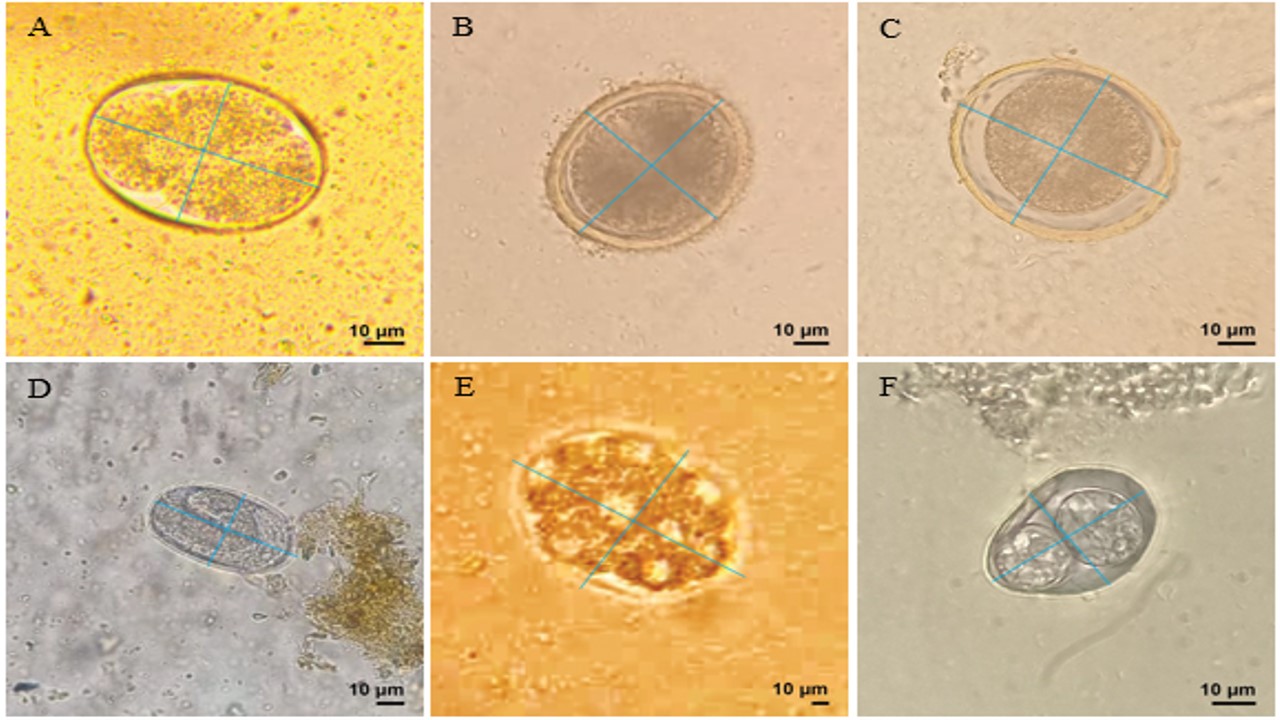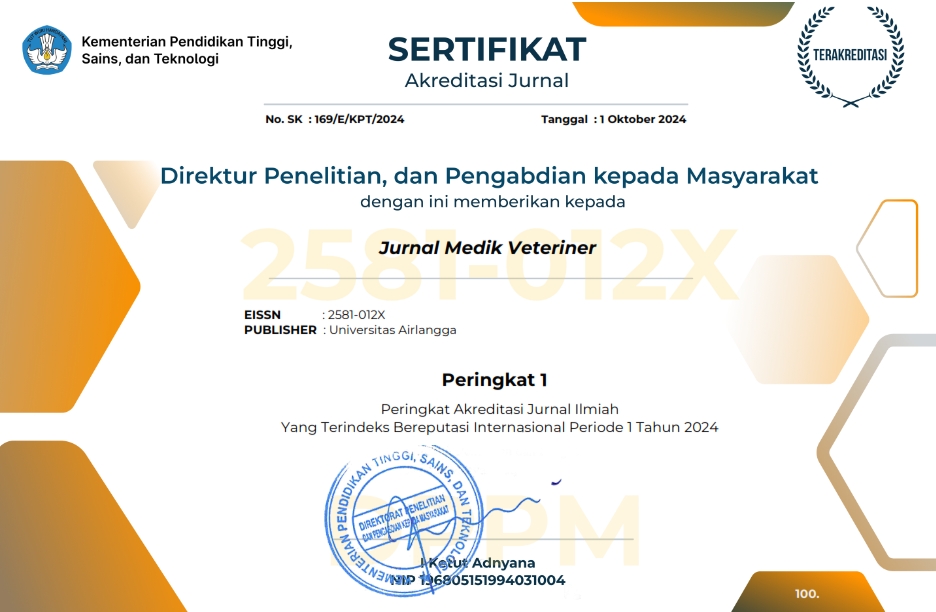Epidemiology and Spatial Distribution of Parasitic Infections in Cats in Malang, East Java, Indonesia: Risk Factors and Public Health Implications

Downloads
Cats are common companion animals that are susceptible to various parasitic infections, particularly under unsanitary environmental conditions. Apart from transmitting zoonotic infections, infected cats may also suffer from metabolic disorders, malnutrition, anemia, and even death. Fecal, hair, and ectoparasite samples from 170 cats (stray and domestic) were collected from 12 districts in Malang. Statistical tests (Chi-square, OR, and RR) and QGIS-based spatial mapping were employed for data analysis. The findings revealed that 46.4% (79/170) of gastrointestinal endoparasite cases involved Ancylostoma spp. (20.6%), Toxocara cati (19.4%), Toxascaris leonina (7.6%), Strongyloides spp. (2.9%), Dipylidium caninum (4.1%), Cystoisospora felis (5.8%), Cystoisospora rivolta (3.5%), and Toxoplasma gondii-like oocysts (1.1%). Ectoparasite infestations accounted for 52.9% (90/170), with Ctenocephalides felis (50.5%), Sarcoptes scabiei (3.5%), Felicola subrostratus (1.1%), and Rhipicephalus sanguineus (0.5%) being recorded. Risk factor analysis revealed a significant correlation (p < 0.05) between lifestyle and the prevalence rates of cat gastrointestinal endoparasite infections and ectoparasite infestations, while sex and altitude showed no significant correlation (p > 0.05) with either. The findings of the study bear significance for both human and animal health, highlighting the importance of interdisciplinary collaboration among preventive medicine, veterinary science, and public health, and providing a valuable evidence base to support policy development and targeted intervention programs aimed at controlling zoonotic parasites in companion animals, particularly in urban and peri-urban areas.
Abossie, A., Seid, M., & Mihret, A. (2017). Diagnostic performance of direct wet mount microscopy in detecting intestinal parasitic infections among patients attending hospital in Southern Ethiopia: A cross-sectional study. BMC Research Notes, 10(1), 1–5.
Adhikari, B., Bhattarai, S., & Shrestha, R. (2023). Survey on the prevalence of intestinal parasites in domestic cats (Felis catus Linnaeus, 1758) in central Nepal. Veterinary Medicine and Science, 9(5), 1156–1164.
Arlian, L. G., and Morgan, M. S. (2017). A review of Sarcoptes scabiei: past, present and future. Parasites & Vectors, 10(1), 297.
Bayou, K., Terefe, G., & Kumsa, B. (2024). Gastrointestinal parasites of owned cats in three districts of Central Ethiopia: Prevalence and risk factors. Veterinary Parasitology: Regional Studies and Reports, 52, 101053.
Blasco, X., Manteca, X., López Béjar, M., Carbajal, A., Castellà, J., & Ortuño, A. (2021). Intestinal parasites and fecal cortisol metabolites in multi-unowned-cat environments: the impact of housing conditions. Animals, 11(5), 1300.
Bonilla-Aldana, J. L., Espinosa-Nuñez, A. C., Bonilla-Aldana, D. K., & Rodriguez-Morales, A. J. (2024). Toxocara cati infection in cats (Felis catus): A systematic review and meta-analysis. Animals, 14(7), 1022.
Chan, J. M., Flores, M. J., Maghirang, E. S., & Chan, H. (2023). Intestinal Helminth Infections Among Domesticated Cats in Malate, Manila, Philippines. Journal of Parasite Science, 7(2), 22.
Firdausy, L. W., Fikri, F., Wicaksono, A. P., Çalışkan, H., & Purnama, M. T. E. (2025). Prevalence of trypanosomiasis in domesticated animals in Indonesia: A systematic review and meta-analysis. Veterinary World, 18(5), 1333–1344.
Geeraedts, F., Wertenbroek, A., de Klerk, J., Prick, J. J., Reichman, L. J. A., Hess, D., Bosma, F., Reimerink, J., Skidmore, B., & Laverman, G. D. (2022). Defining a risk area for tick-borne encephalitis (TBE) in a country where TBE is emerging, the Netherlands, July 2016–October 2020. Ticks and Tick-borne Diseases, 13(2), 101898.
Lia, N. J. S., & Soraya. (2022). Prevalence of Toxocara cati in household and stray cats in Banjaran. Media Bina Ilmiah, 16(11), 7785–7791.
Lee, S. H., Ock, Y., Choi, D. H., & Kwak, D. (2019). Gastrointestinal parasite infection in cats in Daegu, Republic of Korea, and efficacy of treatment using topical emodepside/praziquantel formulation. Parasites, Hosts and Diseases, 57(3), 243–248.
Misa, M. W., Suratma, N. A., & Dwinata, I. M. (2022). Prevalensi infeksi cacing gastrointestinal berpotensi zoonosis pada kucing di Kota Denpasar. Buletin Veteriner Udayana, 6(16), 32.
Montoya, A., García, M., Gálvez, R., Checa, R., Marino, V., & Sarquis, J. (2018). Implications of zoonotic and vector-borne parasites to free-roaming cats in central Spain. Veterinary Parasitology, 251, 125–130.
Moskvina, T. V., & Zheleznova, L. V. (2015). A survey on endoparasites and ectoparasites in domestic dogs and cats in Vladivostok, Russia. Veterinary Parasitology: Regional Studies and Reports, 1–2, 31–34.
Nourollahi Fard, S. R., & Sadeghi, S. (2024). Gastrointestinal helminths infection of free‐roaming cats (Felis catus) in Southeast Iran. Veterinary Medicine and Science, 10(1), e1422.
Qudsiyati, N., Khirqah, A., Muntolip, A., Priyowidodo, D., Indarjulianto, S., & Nurcahyo, R. W. (2022). Cat scabies prevalence at Animal Health Center Pemalang. Jurnal Sains Veteriner, 40(1), 1–6.
Rabbani, I. A. R., Mareta, F. J., Kusnoto, Hastutiek, P., Lastuti, N. D. R., Mufasirin, Suharsono, Sardjana, I. K. W., Sukmanadi, M., & Suwanti, L. T. (2020). Zoonotic and Other Gastrointestinal Parasites in Cats in Lumajang, East Java, Indonesia. Infectious Disease Reports, 12(s1), 8747.
Ramadhanty, M. N., Kusnoto, Hastutiek, P., Mufasirin, Setiawan, B., & Hestianah, E. P. (2024). Scabies prevalence on cats and rabbits in Animal Hospital of East Java Livestock Service in 2021. Journal of Parasite Science, 8(2), 47–50.
Ridwan, Y., Sudarnika, E., Dewi, T. I. T., & Budiono, N. G. (2023). Gastrointestinal helminth parasites of pets: Retrospective study at the veterinary teaching hospital, IPB University, Bogor, Indonesia. Veterinary World, 16(5), 1043–1051.
Rousseau, J., Castro, A., Novo, T., & Maia, C. (2022). Dipylidium caninum in the twenty-first century: epidemiological studies and reported cases in companion animals and humans. Parasites & Vectors, 15(1), 131.
Sánchez-Montes, S., Rendón-Franco, E., & Muñoz-García, C. I. (2023). New records, and molecular detection of vector-borne pathogens in Felicola subrostratus from eastern Mexico. Veterinary Research Communications, 47(4), 1–8.
Sawitri, D. H., Wardhana, A. H., Nefho, F., Purwanto, E. S., Endrawati, D., Nugraheni, Y. R., Primatika, R. A., Damayanti, N. A., Akbari, R. A., Kusumaningtyas, E., & Matsubayashi, M. (2024). Prevalence and risk factors associated with zoonotic gastrointestinal helminths transmitted by cats in Jabodetabek, Indonesia. Open Veterinary Journal, 14(10), 2551–2563.
Schares, G., Globokar Vrhovec, M., Tuschy, M., Joeres, M., Bärwald, A., Koudela, B., Dubey, J. P., Maksimov, P., & Conraths, F. J. (2021). A real-time quantitative polymerase chain reaction for the specific detection of Hammondia hammondi and its differentiation from Toxoplasma gondii. Parasites & Vectors, 14(1), 78.
Seidi, S., Raz, A., Maleki-Ravasan, N., Forouzan, E., Karimian, F., Sebbane, F., Sohrabi, A., Esmaeili, S., & Mostafavi, E. (2025). The interplay between species and locations shapes vector fleas microbial communities in plague foci: pathogens rather than symbionts? Frontiers in Cellular and Infection Microbiology, 15, 1568103.
Siswandi, L. N. A., Sunarso, A., Hamid, I. S., Mufasirin, & Triakoso, N. (2023). Identification of gastrointestinal parasite in hospitalized cats at several animal clinics in Surabaya using faecal examination method. Journal of Parasite Science, 7(1), 31–38.
Subrata, I. M., Oka, I. B. M., & Agustina, K. K. (2017). Prevalence of intestinal worm in free ranging domestic cats in Bali. Jurnal Veteriner, 18(3), 441.
Taetzsch, S. J., Gruszynski, K. R., Bertke, A. S., Dubey, J. P., Monti, K. A., Zajac, A. M., & Lindsay, D. S. (2018). Prevalence of zoonotic parasites in feral cats of Central Virginia, USA. Zoonoses and Public Health, 65(6), 728–735.
Taylor, M. A., Coop, R. L., & Wall, R. L. (2016). Veterinary Parasitology. 4th Edition. Wiley-Blackwell. pp: 44.
Thrusfield, M., Christley, R., Brown, H., Diggle, P., French, N., Howe, K., Kelly, L., O’Connor, A., Sargeant, J., & Wood, H. (2018). Data collection and management. Veterinary Epidemiology, 12(1), 219–250.
Wardhani, H. C. P., Rahmawati, I., & Kurniabudhi, M. (2021). Deteksi dan prevalensi jenis telur cacing feses kucing di Kota Surabaya. Jurnal Biosains, 7(1), 45.
Widhowati, D., Sasmita, R., Astuti Mussa, O. R. P., & Benu, H. A. (2020). Infeksi endoparasit pada kucing domestik (Felis domesticus) di pasar tradisional Kecamatan Sawahan Kota Surabaya. Vitek: Jurnal Kedokteran Hewan, 9, 38–43.
Wierzbowska, I. A., Kornaś, S., Piontek, A. M., & Rola, K. (2020). The prevalence of endoparasites of free-ranging cats (Felis catus) from urban habitats in southern Poland. Animals, 10(4), 748.
Yang, Y., & Liang, H. (2015). Prevalence and risk factors of intestinal parasites in cats from China. BioMed Research International, 2015, 967238.
Zhu, S., VanWormer, E., & Shapiro, K. (2023). More people, more cats, more parasites: Human population density and temperature variation predict prevalence of Toxoplasma gondii oocyst shedding in free-ranging domestic and wild felids. PLOS ONE, 18(6), e0286808.
Zottler, E. M., Bieri, M., Basoo, W., & Schnyder, M. (2019). Intestinal parasites and lungworms in stray, shelter and privately owned cats of Switzerland. Parasitology International, 69, 75–81.
Copyright (c) 2025 Reza Yesica, Hafiz Bintang Pamungkas, Azzam Dhiya’ulhaq Rahardja, Denissa Rachmawati Purnama Putri, Shelly Kusumarini R

This work is licensed under a Creative Commons Attribution-NonCommercial-ShareAlike 4.0 International License.
Authors who publish in this journal agree to the following terms:
1. The journal allows the author to hold the copyright of the article without restrictions;
2. The journal allows the author(s) to retain publishing rights without restrictions;
3. The legal formal aspect of journal publication accessibility refers to Creative Commons Attribution-NonCommercial-ShareAlike 4.0 International License (CC BY-NC-SA).






11.jpg)




















